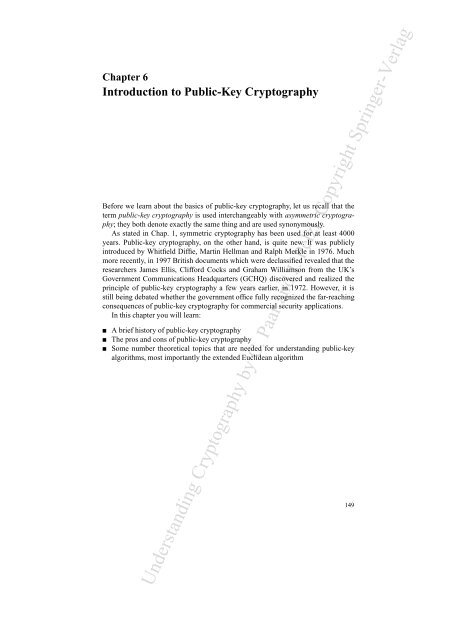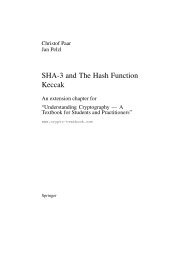Understanding Cryptography by C. Paar and J. Pelzl, Copyright ...
Understanding Cryptography by C. Paar and J. Pelzl, Copyright ...
Understanding Cryptography by C. Paar and J. Pelzl, Copyright ...
You also want an ePaper? Increase the reach of your titles
YUMPU automatically turns print PDFs into web optimized ePapers that Google loves.
Chapter 6<br />
Introduction to Public-Key <strong>Cryptography</strong><br />
Before we learn about the basics of public-key cryptography, let us recall that the<br />
term public-key cryptography is used interchangeably with asymmetric cryptography;<br />
they both denote exactly the same thing <strong>and</strong> are used synonymously.<br />
As stated in Chap. 1, symmetric cryptography has been used for at least 4000<br />
years. Public-key cryptography, on the other h<strong>and</strong>, is quite new. It was publicly<br />
introduced <strong>by</strong> Whitfield Diffie, Martin Hellman <strong>and</strong> Ralph Merkle in 1976. Much<br />
more recently, in 1997 British documents which were declassified revealed that the<br />
researchers James Ellis, Clifford Cocks <strong>and</strong> Graham Williamson from the UK’s<br />
Government Communications Headquarters (GCHQ) discovered <strong>and</strong> realized the<br />
principle of public-key cryptography a few years earlier, in 1972. However, it is<br />
still being debated whether the government office fully recognized the far-reaching<br />
consequences of public-key cryptography for commercial security applications.<br />
In this chapter you will learn:<br />
A brief history of public-key cryptography<br />
The pros <strong>and</strong> cons of public-key cryptography<br />
Some number theoretical topics that are needed for underst<strong>and</strong>ing public-key<br />
algorithms, most importantly the extended Euclidean algorithm<br />
<strong>Underst<strong>and</strong>ing</strong> <strong>Cryptography</strong> <strong>by</strong> C. <strong>Paar</strong> <strong>and</strong> J. <strong>Pelzl</strong>, <strong>Copyright</strong> Springer-Verlag<br />
149
150 <strong>Underst<strong>and</strong>ing</strong> <strong>Cryptography</strong> <strong>by</strong> C. <strong>Paar</strong> <strong>and</strong> J. <strong>Pelzl</strong>, <strong>Copyright</strong> Springer-Verlag<br />
6.1 Symmetric vs. Asymmetric <strong>Cryptography</strong><br />
In this chapter we will see that asymmetric, i.e., public-key, algorithms are very different<br />
from symmetric algorithms such as AES or DES. Most public-key algorithms<br />
are based on number-theoretic functions. This is quite different from symmetric ciphers,<br />
where the goal is usually not to have a compact mathematical description<br />
between input <strong>and</strong> output. Even though mathematical structures are often used for<br />
small blocks within symmetric ciphers, for instance, in the AES S-Box, this does<br />
not mean that the entire cipher forms a compact mathematical description.<br />
Symmetric <strong>Cryptography</strong> Revisited<br />
In order to underst<strong>and</strong> the principle of asymmetric cryptography, let us first recall<br />
the basic symmetric encryption scheme in Fig. 6.1.<br />
<br />
Fig. 6.1 Principle of symmetric-key encryption<br />
<br />
Such a system is symmetric with respect to two properties:<br />
1. The same secret key is used for encryption <strong>and</strong> decryption.<br />
2. The encryption <strong>and</strong> decryption function are very similar (in the case of DES they<br />
are essentially identical).<br />
There is a simple analogy for symmetric cryptography, as shown in Fig. 6.2.<br />
Assume there is a safe with a strong lock. Only Alice <strong>and</strong> Bob have a copy of the<br />
key for the lock. The action of encrypting of a message can be viewed as putting the<br />
message in the safe. In order to read, i.e., decrypt, the message, Bob uses his key<br />
<strong>and</strong> opens the safe.<br />
Modern symmetric algorithms such as AES or 3DES are very secure, fast <strong>and</strong><br />
are in widespread use. However, there are several shortcomings associated with<br />
symmetric-key schemes, as discussed below.<br />
Key Distribution Problem The key must be established between Alice <strong>and</strong> Bob<br />
using a secure channel. Remember that the communication link for the message is<br />
not secure, so sending the key over the channel directly — which would be the most<br />
convenient way of transporting it — can’t be done.<br />
Number of Keys Even if we solve the key distribution problem, we must potentially<br />
deal with a very large number of keys. If each pair of users needs a separate<br />
pair of keys in a network with n users, there are<br />
<strong>Underst<strong>and</strong>ing</strong> <strong>Cryptography</strong> <strong>by</strong> C. <strong>Paar</strong> <strong>and</strong> J. <strong>Pelzl</strong>, <strong>Copyright</strong> Springer-Verlag
<strong>Underst<strong>and</strong>ing</strong> <strong>Cryptography</strong> <strong>by</strong> C. <strong>Paar</strong> <strong>and</strong> J. <strong>Pelzl</strong>, <strong>Copyright</strong> Springer-Verlag 151<br />
Alice<br />
Fig. 6.2 Analogy for symmetric encryption: a safe with one lock<br />
n ·(n − 1)<br />
2<br />
Bob<br />
key pairs, <strong>and</strong> every user has to store n − 1 keys securely. Even for mid-size networks,<br />
say, a corporation with 2000 people, this requires more than 4 million key<br />
pairs that must be generated <strong>and</strong> transported via secure channels. More about this<br />
problem is found in Sect. 13.1.3. (There are smarter ways of dealing with keys<br />
in symmetric cryptography networks as detailed in Sect. 13.2; however, those approaches<br />
have other problems such as a single point of failure.)<br />
No Protection Against Cheating <strong>by</strong> Alice or Bob Alice <strong>and</strong> Bob have the same<br />
capabilities, since they possess the same key. As a consequence, symmetric cryptography<br />
cannot be used for applications where we would like to prevent cheating <strong>by</strong><br />
either Alice or Bob as opposed to cheating <strong>by</strong> an outsider like Oscar. For instance,<br />
in e-commerce applications it is often important to prove that Alice actually sent a<br />
certain message, say, an online order for a flat screen TV. If we only use symmetric<br />
cryptography <strong>and</strong> Alice changes her mind later, she can always claim that Bob,<br />
the vendor, has falsely generated the electronic purchase order. Preventing this is<br />
called nonrepudiation <strong>and</strong> can be achieved with asymmetric cryptography, as discussed<br />
in Sect. 10.1.1. Digital signatures, which are introduced in Chap. 10, provide<br />
nonrepudiation.<br />
Alice<br />
public key<br />
deposit<br />
unlock<br />
<strong>Underst<strong>and</strong>ing</strong> <strong>Cryptography</strong> <strong>by</strong> C. <strong>Paar</strong> <strong>and</strong> J. <strong>Pelzl</strong>, <strong>Copyright</strong> Springer-Verlag<br />
Bob<br />
private key<br />
Fig. 6.3 Analogy for public-key encryption: a safe with public lock for depositing a message <strong>and</strong><br />
a secret lock for retrieving a message
152 <strong>Underst<strong>and</strong>ing</strong> <strong>Cryptography</strong> <strong>by</strong> C. <strong>Paar</strong> <strong>and</strong> J. <strong>Pelzl</strong>, <strong>Copyright</strong> Springer-Verlag<br />
Principles of Asymmetric <strong>Cryptography</strong><br />
In order to overcome these drawbacks, Diffie, Hellman <strong>and</strong> Merkle had a revolutionary<br />
proposal based on the following idea: It is not necessary that the key possessed<br />
<strong>by</strong> the person who encrypts the message (that’s Alice in our example) is secret. The<br />
crucial part is that Bob, the receiver, can only decrypt using a secret key. In order<br />
to realize such a system, Bob publishes a public encryption key which is known to<br />
everyone. Bob also has a matching secret key, which is used for decryption. Thus,<br />
Bob’s key k consists of two parts, a public part, k pub , <strong>and</strong> a private one, k pr .<br />
A simple analogy of such a system is shown in Fig. 6.3. This systems works quite<br />
similarly to the good old mailbox on the corner of a street: Everyone can put a letter<br />
in the box, i.e., encrypt, but only a person with a private (secret) key can retrieve<br />
letters, i.e., decrypt. If we assume we have cryptosystems with such a functionality,<br />
a basic protocol for public-key encryption looks as shown in Fig. 6.4.<br />
Alice<br />
y = e kpub (x)<br />
k pub<br />
←−−−−−−−−−−−−<br />
y<br />
−−−−−−−−−−−−→<br />
Fig. 6.4 Basic protocol for public-key encryption<br />
<strong>Underst<strong>and</strong>ing</strong> <strong>Cryptography</strong> <strong>by</strong> C. <strong>Paar</strong> <strong>and</strong> J. <strong>Pelzl</strong>, <strong>Copyright</strong> Springer-Verlag<br />
Bob<br />
(k pub ,k pr ) = k<br />
x = d kpr (y)<br />
By looking at that protocol you might argue that even though we can encrypt a<br />
message without a secret channel for key establishment, we still cannot exchange a<br />
key if we want to encrypt with, say, AES. However, the protocol can easily be modified<br />
for this use. What we have to do is to encrypt a symmetric key, e.g., an AES<br />
key, using the public-key algorithm. Once the symmetric key has been decrypted<br />
<strong>by</strong> Bob, both parties can use it to encrypt <strong>and</strong> decrypt messages using symmetric<br />
ciphers. Figure 6.5 shows a basic key transport protocol where we use AES as the<br />
symmetric cipher for illustration purposes (of course, one can use any other symmetric<br />
algorithm in such a protocol). The main advantage of the protocol in Fig. 6.5<br />
over the protocol in Fig. 6.4 is that the payload is encrypted with a symmetric cipher,<br />
which tends to be much faster than an asymmetric algorithm.<br />
From the discussion so far, it looks as though asymmetric cryptography is a<br />
desirable tool for security applications. The question remains how one can build<br />
public-key algorithms. In Chaps. 7, 8 <strong>and</strong> 9 we introduce most asymmetric schemes<br />
of practical relevance. They are all built from one common principle, the one-way<br />
function. The informal definition of it is as follows:
<strong>Underst<strong>and</strong>ing</strong> <strong>Cryptography</strong> <strong>by</strong> C. <strong>Paar</strong> <strong>and</strong> J. <strong>Pelzl</strong>, <strong>Copyright</strong> Springer-Verlag 153<br />
Alice<br />
choose r<strong>and</strong>om k<br />
y = e kpub (k)<br />
encrypt message x:<br />
z = AES k (x)<br />
k pub<br />
←−−−−−−−−−−−−<br />
y<br />
−−−−−−−−−−−−→<br />
z<br />
−−−−−−−−−−−−→<br />
<strong>Underst<strong>and</strong>ing</strong> <strong>Cryptography</strong> <strong>by</strong> C. <strong>Paar</strong> <strong>and</strong> J. <strong>Pelzl</strong>, <strong>Copyright</strong> Springer-Verlag<br />
Bob<br />
k pub ,k pr<br />
k = d kpr (y)<br />
x = AES −1 (z)<br />
Fig. 6.5 Basic key transport protocol with AES as an example of a symmetric cipher<br />
Definition 6.1.1 One-way function<br />
A function f() is a one-way function if:<br />
1. y = f(x) is computationally easy, <strong>and</strong><br />
2. x = f −1 (y) is computationally infeasible.<br />
Obviously, the adjectives “easy” <strong>and</strong> “infeasible” are not particularly exact. In<br />
mathematical terms, a function is easy to compute if it can be evaluated in polynomial<br />
time, i.e., its running time is a polynomial expression. In order to be useful in<br />
practical crypto schemes, the computation y = f(x) should be sufficiently fast that<br />
it does not lead to unacceptably slow execution times in an application. The inverse<br />
computation x = f −1 (y) should be so computationally intensive that it is not feasible<br />
to evaluate it in any reasonable time period, say, 10,000 years, when using the<br />
best known algorithm.<br />
There are two popular one-way functions which are used in practical public-key<br />
schemes. The first is the integer factorization problem, on which RSA is based.<br />
Given two large primes, it is easy to compute the product. However, it is very difficult<br />
to factor the resulting product. In fact, if each of the primes has 150 or more<br />
decimal digits, the resulting product cannot be factored, even with thous<strong>and</strong>s of PCs<br />
running for many years. The other one-way function that is used widely is the discrete<br />
logarithm problem. This is not quite as intuitive <strong>and</strong> is introduced in Chap. 8.<br />
6.2 Practical Aspects of Public-Key <strong>Cryptography</strong><br />
Actual public-key algorithms will be introduced in the next chapters, since there is<br />
some mathematics we must study first. However, it is very interesting to look at the<br />
principal security functions of public-key cryptography which we address in this<br />
section.<br />
k









